A Strain Transfer Model for Detection of Pitting Corrosion and Loading Force of Steel Rebar with Distributed Fiber Optic Sensor
Abstract
:1. Introduction
2. Materials and Methods
2.1. Specimen Praparation
2.2. Installation of DFOS
2.3. Tensile Tests
3. Numerical Simulation
4. Results
Strain Distribution of the DFOS
5. Strain Transfer Model
5.1. Strain Distribution and Strain Transfer of Steel Rebars with Pitting Corrosion
5.2. Model Validation
6. Estimation of Pit Depth and Loading Force
7. Application of the Strain Transfer Model on the Estimation of Actual Corrosion Pit
8. Conclusions
- A strain transfer model was developed between a corroded steel rebar and a DFOS considering pitting-corrosion-induced strain variation in the steel rebar, and the strain distribution in the DFOS was analytically determined by solving the governing equation of the strain transfer model.
- A Gaussian function was proposed to fit the strain distribution near the corrosion pit in the steel rebar, and the fitting parameters were dependent on the loading force and the pit depth.
- The strain distribution of the DFOS analytically obtained based on the proposed strain transfer model agreed well with the actual strain distribution of the DFOSs embedded in the steel rebars during tensile tests.
- The pit depth and loading force in the steel rebars were estimated based on the proposed strain transfer model, and the estimated values agreed well with the actual pit depth and loading force.
- The source of errors between the estimated and the actual pit depth or loading force were mainly from (i) the simplified strain distribution near the corrosion pit of steel rebars with the Gaussian function; (ii) the assumed linear elasticity of the intermediate materials between the steel rebars and the DFOS, as well as a perfect bond between them; and (iii) the difference between the FE-simulated strain and the actual strain in the steel rebars during tensile tests.
Author Contributions
Funding
Data Availability Statement
Conflicts of Interest
References
- Sagues, A.A.; Lau, K.; Powers, R.G.; Kessler, R.J. Corrosion of epoxy-coated rebar in marine bridges-Part 1: A 30-year perspective. Corrosion 2010, 66, 065001. [Google Scholar] [CrossRef]
- Liu, J.; Zhang, W.; Li, Z.; Jin, H.; Tang, L. Influence of deicing salt on the surface properties of concrete specimens after 20 years. Constr. Build. Mater. 2021, 295, 123643. [Google Scholar] [CrossRef]
- Bui, H.T.; Tan, K.H. Multi-peak nonuniform model of rust distribution and corrosion-induced concrete cracking in reinforced concrete slabs. Cem. Concr. Compos. 2023, 140, 105087. [Google Scholar] [CrossRef]
- Imperatore, S.; Rinaldi, Z.; Drago, C. Degradation relationships for the mechanical properties of corroded steel rebars. Constr. Build. Mater. 2017, 148, 219–230. [Google Scholar] [CrossRef]
- Li, D.; Wei, R.; Xing, F.; Sui, L.; Zhou, Y.; Wang, W. Influence of non-uniform corrosion of steel bars on the seismic behavior of reinforced concrete beams. Constr. Build. Mater. 2018, 167, 20–32. [Google Scholar] [CrossRef]
- Zhang, T.; Cui, X.; Li, P.; Li, X.; Wang, S.; Zhang, C. Stiffness degradation analysis of reinforced concrete beams under corrosion-fatigue coupling action based on experimental research. Structures 2023, 54, 1278–1298. [Google Scholar] [CrossRef]
- Yu, X.; Qian, K.; Lu, D.; Li, B. Progressive collapse behavior of aging reinforced concrete structures considering corrosion effects. ASCE J. Perform. Constr. Facil. 2017, 31, 04017009. [Google Scholar] [CrossRef]
- Rodrigues, R.; Gaboreau, S.; Gance, J.; Ignatiadis, I.; Betelu, S. Reinforced concrete structures: A review of corrosion mechanism and advances in electrical methods for corrosion monitoring. Constr. Build. Mater. 2021, 269, 121240. [Google Scholar] [CrossRef]
- Fan, L.; Shi, X. Technique of corrosion monitoring of steel rebar in reinforced concrete structures: A review. Struct. Health Monit. 2021, 21, 1879–1905. [Google Scholar] [CrossRef]
- Li, H.; Li, D.; Song, G. Recent applications of fiber optic sensors to health monitoring in civil engineering. Eng. Struct. 2004, 26, 1647–1657. [Google Scholar] [CrossRef]
- Tang, F.; Zhou, G.; Li, H.; Verstrynge, E. A review on fiber optic sensors for rebar corrosion monitoring in RC structures. Constr. Build. Mater. 2021, 313, 125578. [Google Scholar] [CrossRef]
- Tan, C.H.; Shee, Y.G.; Yap, B.K.; Adikan, F.R.M. Fiber Bragg grating based sensing system: Early corrosion detection for structural health monitoring. Sens. Actuators A Phys. 2016, 246, 123–128. [Google Scholar] [CrossRef]
- Liu, H.; Liang, D.; Zeng, J.; Jin, J.; Wu, J.; Geng, J. Design of a long-period fiber grating sensor for reinforcing bar corrosion in concrete. J. Intell. Mater. Syst. Struct. 2012, 23, 45–51. [Google Scholar] [CrossRef]
- Huang, Y.; Gao, Z.; Chen, G.; Xiao, H. Long period fiber grating sensors coated with nano iron/silica particles for corrosion monitoring. Smart Mater. Struct. 2013, 22, 075018. [Google Scholar] [CrossRef]
- Maalej, M.; Ahmed, S.F.U.; Kuang, K.S.C.; Paramasivam, P. Fiber optic sensing for monitoring corrosion-induced damage. Struct. Health Monit. 2004, 3, 165–176. [Google Scholar] [CrossRef]
- Tang, F.; Zhou, G.; Li, T.; Dang, J.; Li, H. Fe-C coated single-mode-multimode-single-mode optical fiber sensor for steel corrosion monitoring. IEEE Sens. J. 2022, 22, 18508–18516. [Google Scholar] [CrossRef]
- Zhao, L.; Tang, F.; Verstrynge, E.; Ren, L.; Li, H. Experimental and numerical investigation into corrosion-induced mortar/concrete cracking with distributed optical fiber sensors. J. Civil. Struct. Health Monit. 2022, 12, 943–960. [Google Scholar] [CrossRef]
- Drissi-Habti, M.; Raman, V.; Khadour, A.; Timorian, S. Fiber optic sensor embedment study for multi-parameter strain sensing. Sensors 2017, 17, 667. [Google Scholar] [CrossRef]
- Raman, V.; Drissi-Habti, M.; Limje, P.; Khadour, A. Finer SHM-coverage of inter-plies and bondings in smart composite by dual sinusoidal placed distributed optical fiber sensors. Sensors 2019, 19, 742. [Google Scholar] [CrossRef]
- Xu, D.S.; Liu, H.B.; Luo, W.L. Evaluation of interface shear behavior of GFRP soil nails with a strain-transfer model and distributed fiber-optic sensors. Comput. Geotech. 2018, 95, 180–190. [Google Scholar] [CrossRef]
- Fan, L.; Bao, Y.; Meng, W.; Chen, G. In-situ monitoring of corrosion-induced expansion and mass loss of steel bar in steel fiber reinforced concrete using a distributed fiber optic sensor. Compos. Part B Eng. 2019, 165, 679–689. [Google Scholar] [CrossRef]
- Wang, Q.; Zhang, C.; Ma, Z.; Ni, Y. Modelling and forecasting of SHM strain measurement for a large-scale suspension bridge during typhoon events using variational heteroscedastic Gaussian process. Eng. Struct. 2022, 251, 113554. [Google Scholar] [CrossRef]
- Wang, Q.A.; Zhang, C.; Ma, Z.G.; Jiao, G.Y.; Jiang, X.W.; Ni, Y.Q.; Wang, Y.C.; Du, Y.T.; Qu, G.B.; Huang, J. Towards long-transmission-distance and semi-active wireless strain sensing enabled by dual-interrogation-mode RFID technology. Struct. Control Health Monit. 2022, 29, e3069. [Google Scholar] [CrossRef]
- Hoult, N.A.; Ekim, O.; Regier, R. Damage/deterioration detection for steel structures using distributed fiber optic strain sensors. ASCE J. Eng. Mech. 2014, 140, 04014097. [Google Scholar] [CrossRef]
- Wang, H.; Dai, J. Strain transfer analysis of fiber Bragg grating sensor assembled composite structures subjected to thermal loading. Compos. Part B Eng. 2019, 162, 303–313. [Google Scholar] [CrossRef]
- Zheng, X.; Shi, B.; Zhang, C.; Sun, Y.; Zhang, L.; Han, H. Strain transfer mechanism in surface-bonded distributed fiber-optic sensors subjected to linear strain gradients: Theoretical modeling and experimental validation. Measurement 2021, 179, 109510. [Google Scholar] [CrossRef]
- Ansari, F.; Libo, Y. Mechanics of Bond and Interface Shear Transfer in Optical Fiber Sensors. J. Eng. Mech. 1998, 124, 385–394. [Google Scholar] [CrossRef]
- Li, Q.; Li, G.; Wang, G.; Ansari, F.; Liu, Q. Elasto-Plastic Bonding of Embedded Optical Fiber Sensors in Concrete. J. Eng. Mech. 2002, 128, 471–478. [Google Scholar] [CrossRef]
- Huang, Y.; Bao, Y.; Chen, G.; Zhou, Z. A constrained cylinder model of strain transfer for packaged fiber Bragg grating sensors embedded in inelastic medium. Struct. Control Health Monit. 2019, 26, e2335. [Google Scholar] [CrossRef]
- Zhao, L.; Tang, F.; Li, H.; Ansari, F. Characterization of OFDR distributed optical fiber for crack monitoring considering fiber-coating interfacial slip. Struct. Health Monit. 2022, 22, 180–200. [Google Scholar] [CrossRef]
- Kim, S.; Jeong, M.; Lee, I.; Kim, E.; Kwon, I.; Hwang, T. Determination of the maximum strains experienced by composite structures using metal coated optical fiber sensors. Compos. Sci. Technol. 2013, 78, 48–55. [Google Scholar] [CrossRef]
- Wan, K.T.; Leung, C.K.Y.; Olson, N.G. Investigation of the strain transfer for surface-attached optical fiber strain sensors. Smart Mater. Struct. 2008, 17, 035037. [Google Scholar] [CrossRef]
- Her, S.; Huang, C. Effect of coating on the strain transfer of optical fiber sensors. Sensors 2011, 11, 6926–6941. [Google Scholar] [CrossRef] [PubMed]
- Landreau, C.; Morana, A.; Ponthus, N.; Le Gall, T.; Charvin, J.; Girard, S.; Marin, E. Influence of adhesive bonding on the dynamic and static strain transfers of fibre optic sensors. Photonic 2023, 10, 996. [Google Scholar] [CrossRef]
- Floris, I.; Sangiorgio, V.; Adam, J.M.; Uva, G.; Rapido, M.; Calderón, P.A.; Madrigal, J. Effects of bonding on the performance of optical fiber strain sensors. Struct. Control Health Monit. 2021, 28, e2782. [Google Scholar] [CrossRef]
- Li, J.; Zhou, Z.; Ou, J. Interface strain transfer mechanism and error modification for adhered FBG strain sensor. In Fundamental Problems of Optoelectronics and Microelectronics II; SPIE: Washington, DC, USA, 2005; pp. 278–287. [Google Scholar]
- Bado, M.F.; Casas, J.R.; Dey, A.; Berrocal, C.G. Distributed optical fiber sensing bonding techniques performance for embedment inside reinforced concrete structures. Sensors 2020, 20, 5788. [Google Scholar] [CrossRef]
- Li, H.; Zhou, G.; Ren, L.; Li, D. Strain transfer coefficient analyses for embedded fiber Bragg grating sensors in different host materials. ASCE J. Eng. Mech. 2009, 135, 1343–1353. [Google Scholar] [CrossRef]
- Zhang, S.; Liu, H.; Coulibaly, A.A.S.; DeJong, M. Fiber optic sensing of concrete cracking and rebar deformation using several types of cable. Struct. Control Health Monit. 2021, 28, e2664. [Google Scholar] [CrossRef]
- Tan, X.; Bao, Y.; Zhang, Q.; Nassif, H.; Chen, G. Strain transfer effect in distributed fiber optic sensors under an arbitrary field. Automat. Constr. 2021, 124, 103597. [Google Scholar] [CrossRef]
- Bassil, A.; Chapeleau, X.; Leduc, D.; Abraham, O. Concrete crack monitoring using a novel strain transfer model for distributed fiber optic sensors. Sensors 2020, 20, 2220. [Google Scholar] [CrossRef]

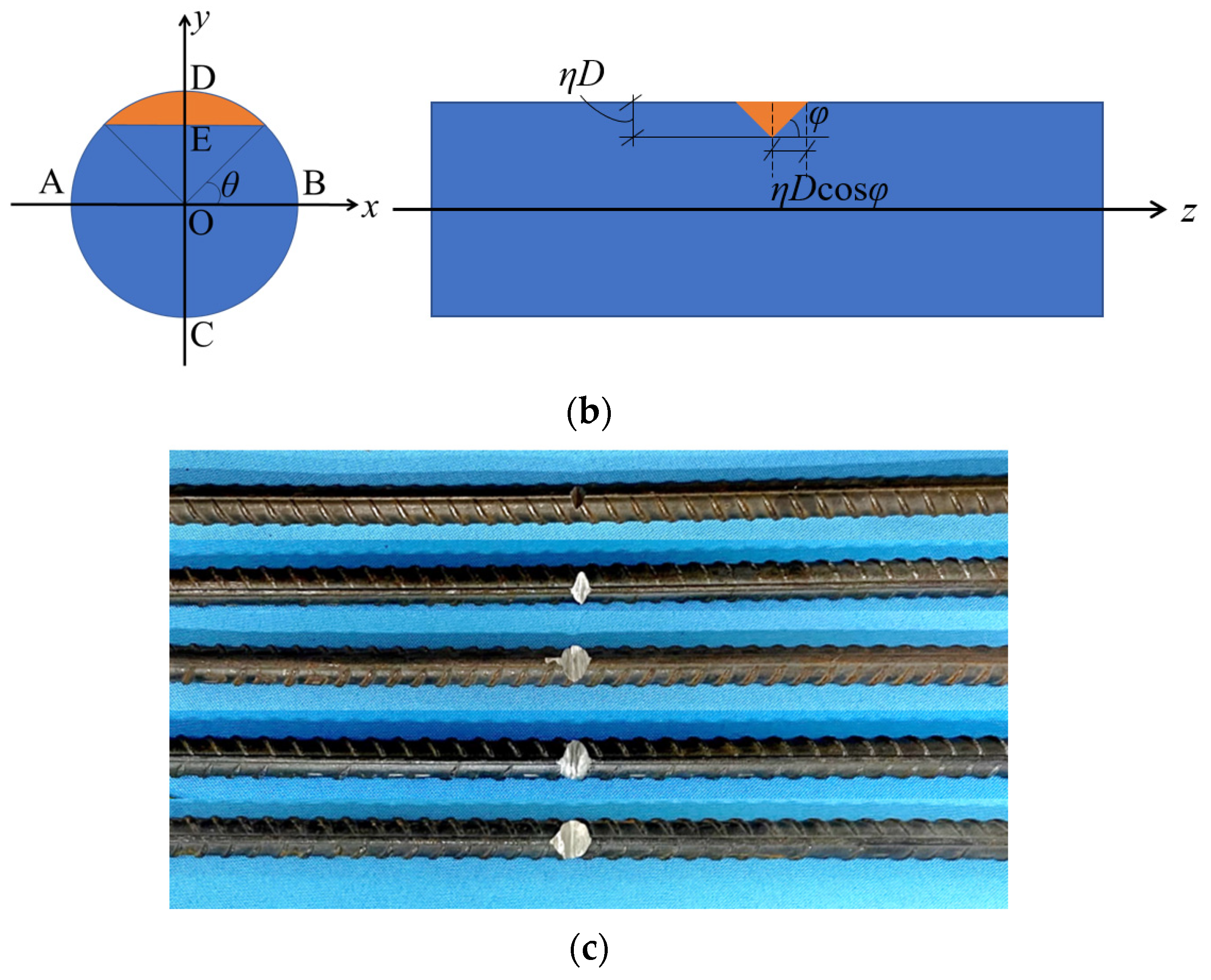


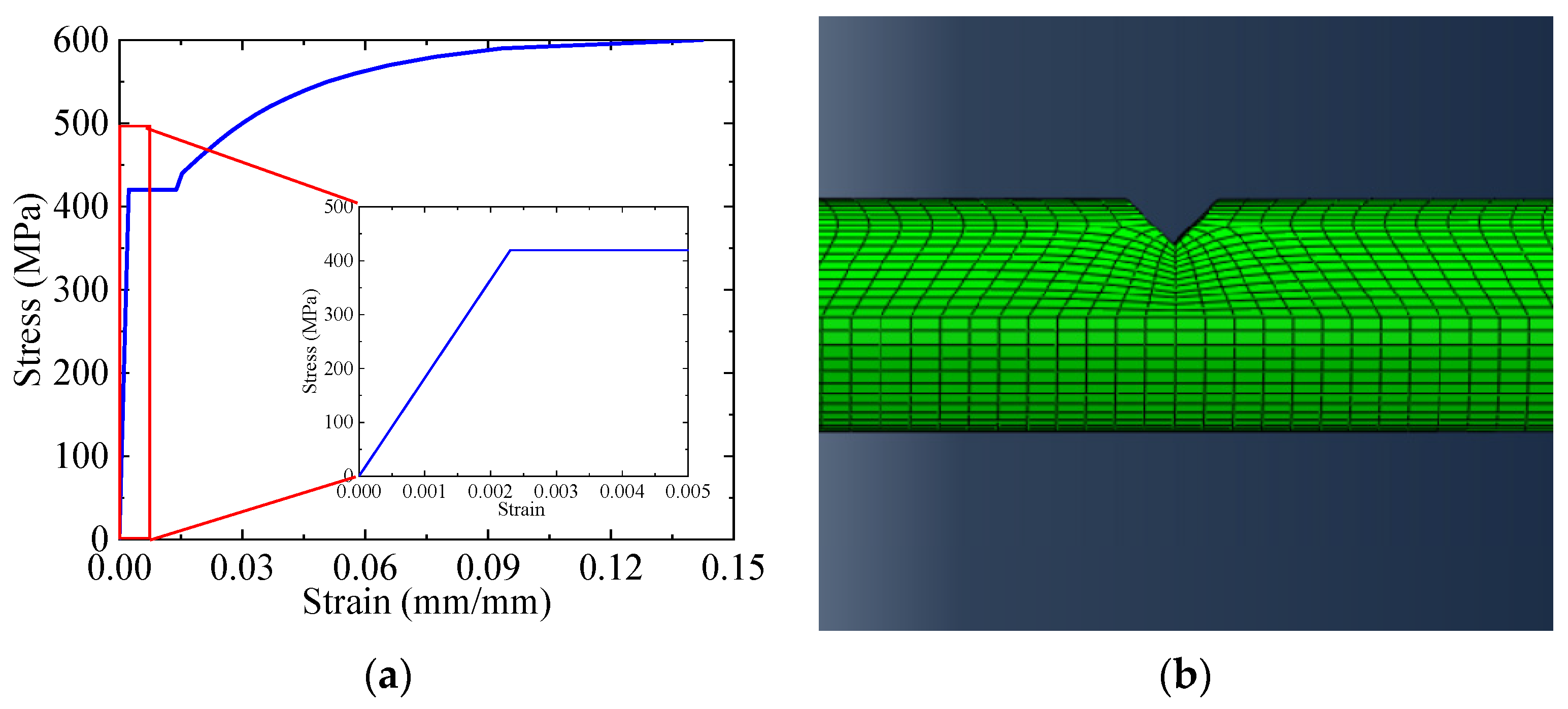

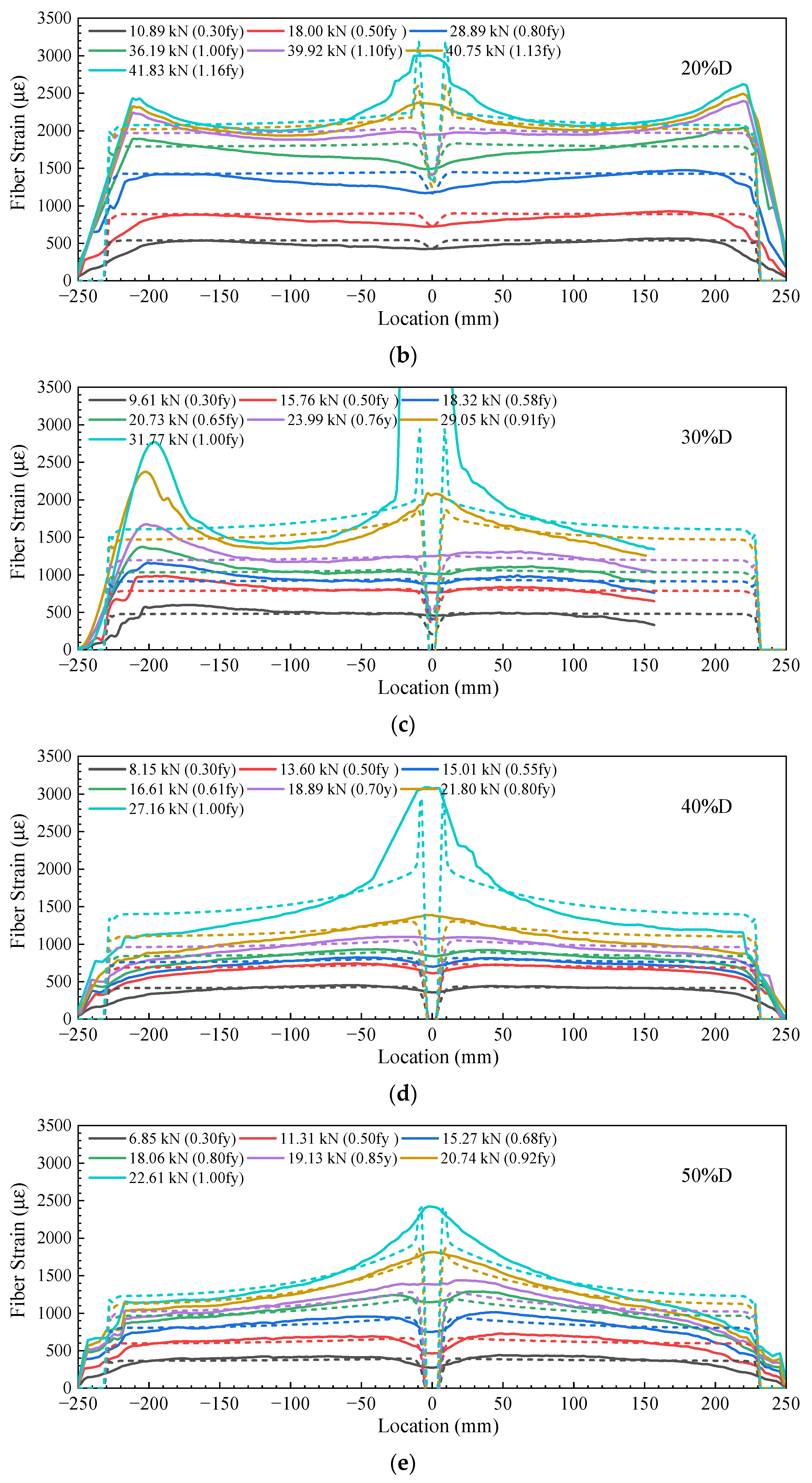
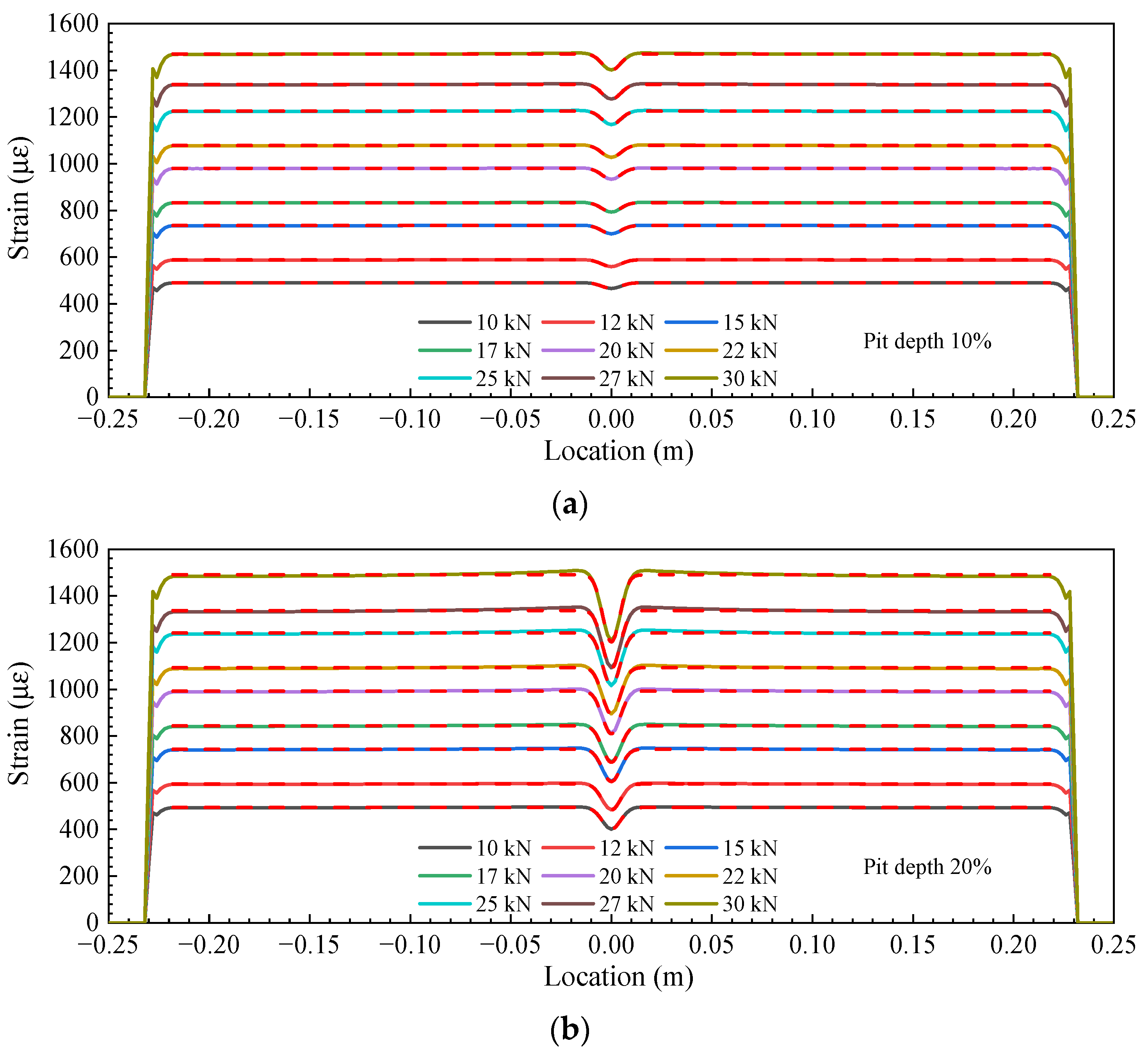

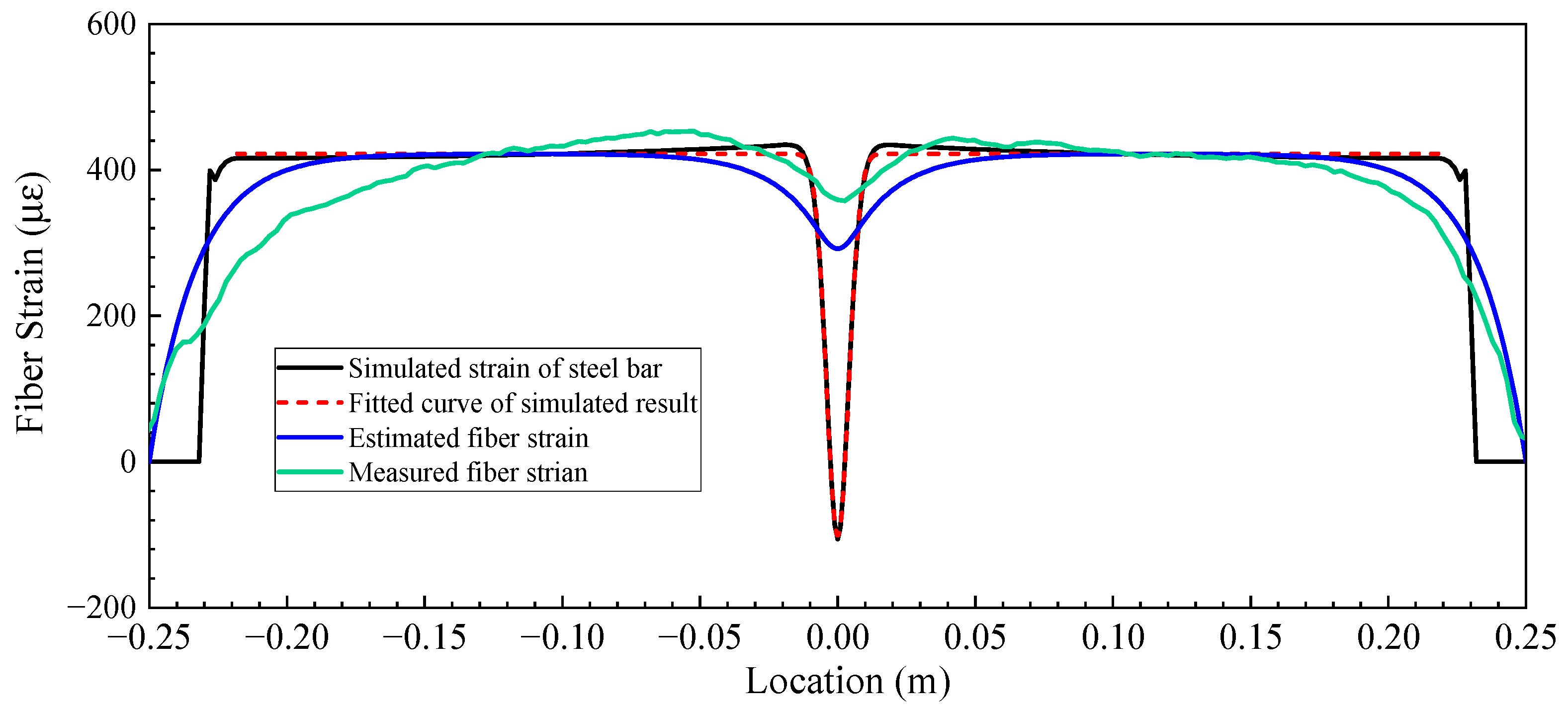
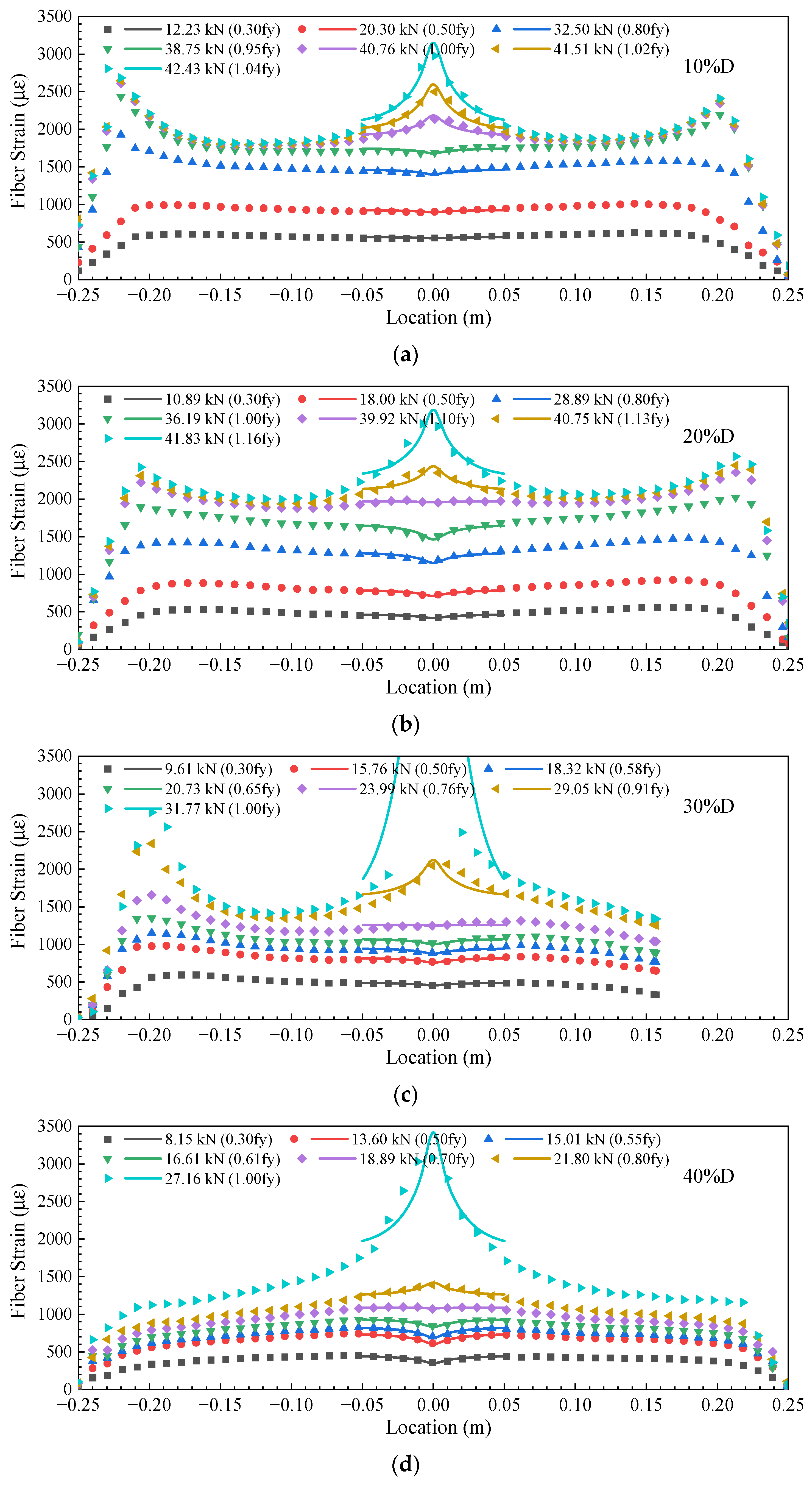
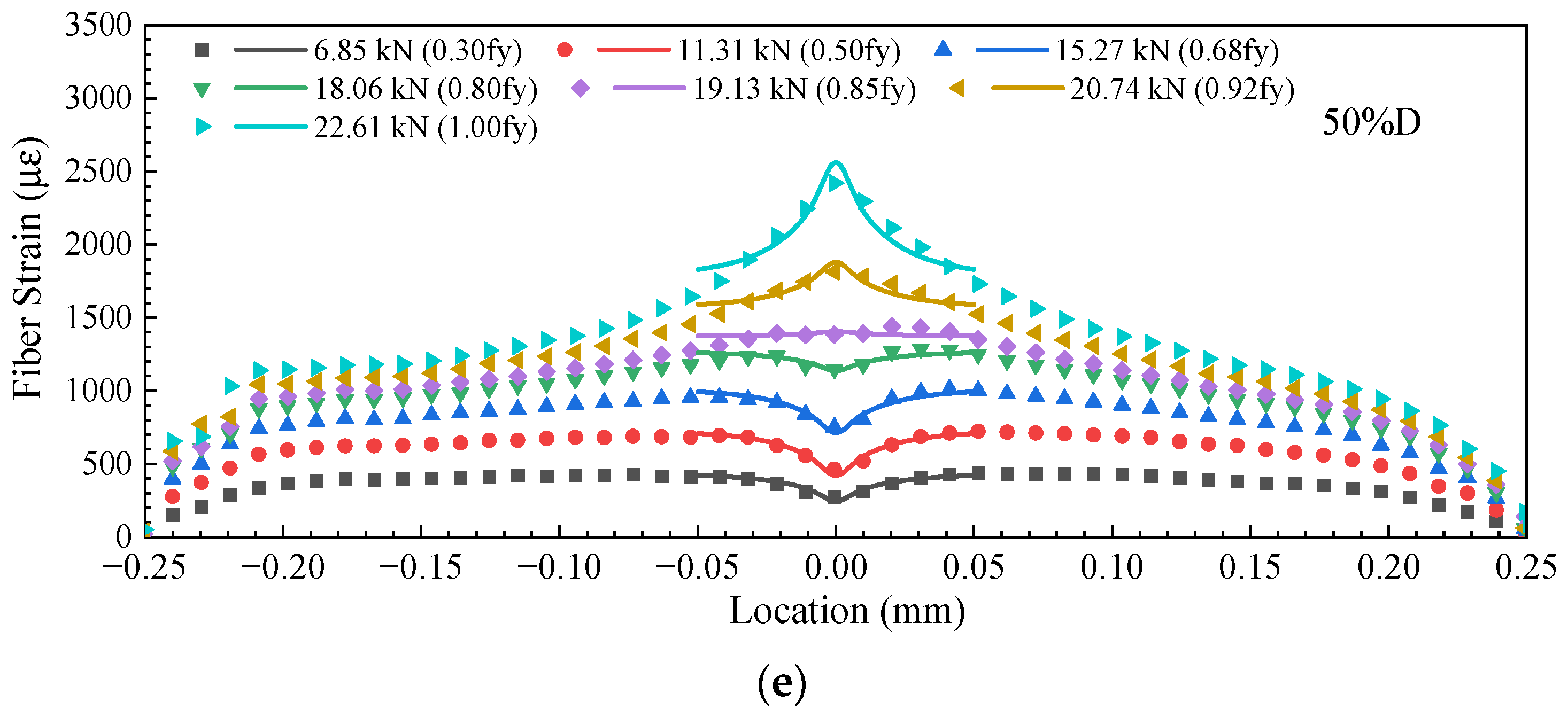
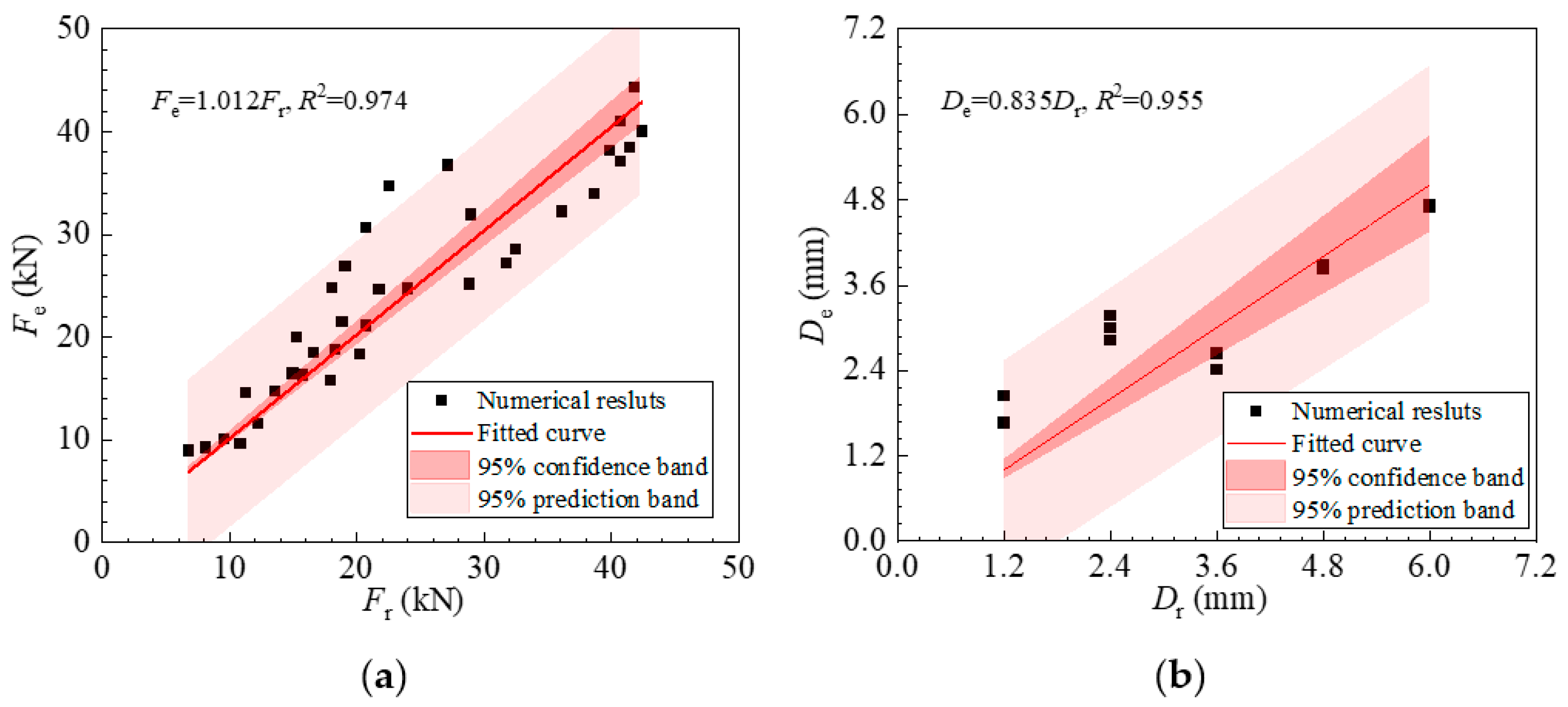
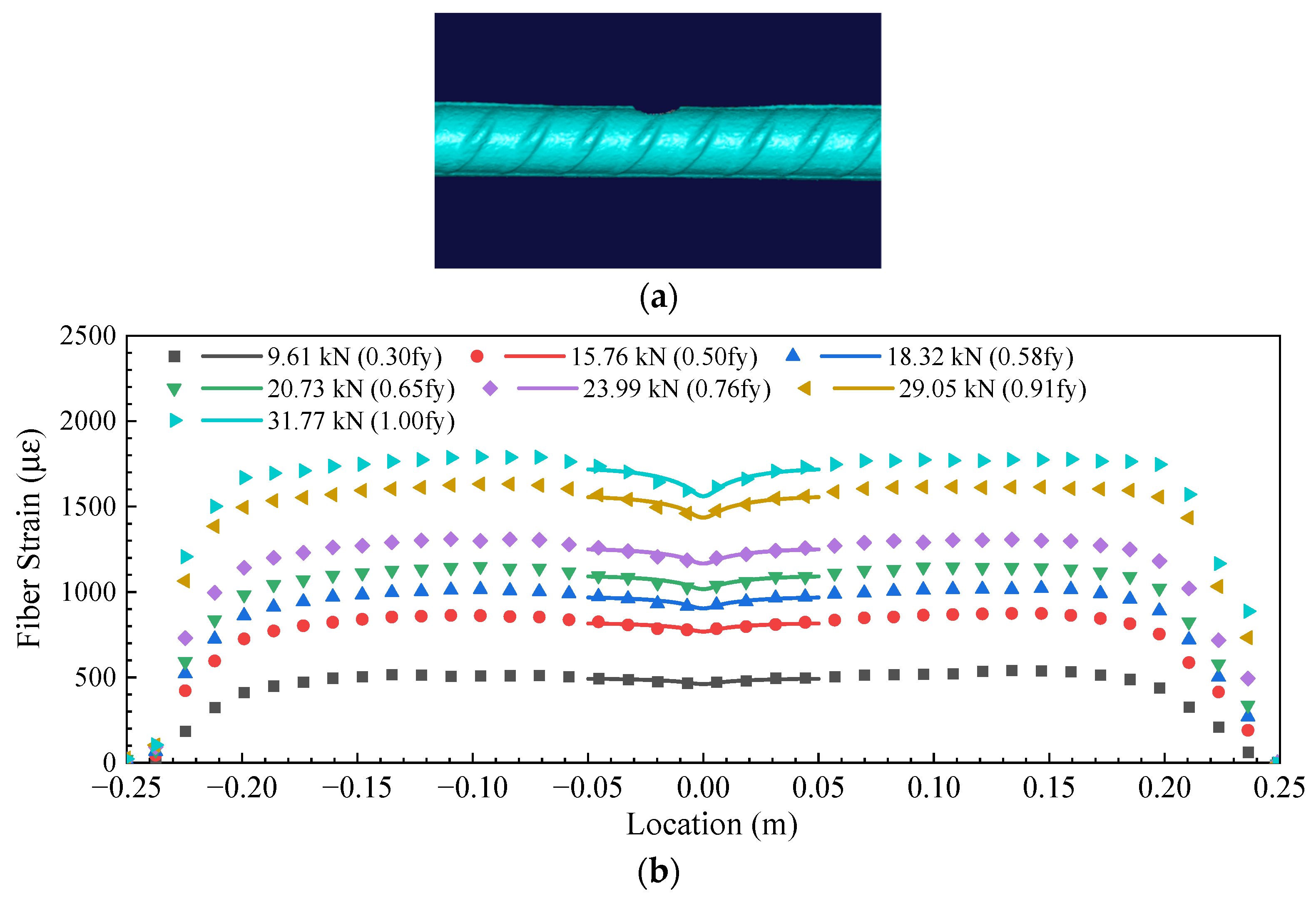
| Depth of V-Shaped Cut (D%) (mm) | Residual Cross-Sectional Area (mm2) | Mass Loss (%) |
|---|---|---|
| 1.2 (10%) | 107 | 5.2 |
| 2.4 (20%) | 97 | 14.2 |
| 3.6 (30%) | 85 | 25.2 |
| 4.8 (40%) | 71 | 37.4 |
| 6.0 (50%) | 57 | 50.0 |
| Material | Radius (μm) | Shear Modulus (GPa) | Poisson’s Ratio |
|---|---|---|---|
| Fiber core and cladding | 62.5 | 28.6 | 0.26 |
| Fiber coating | 95 | 7.0 × 10−4 | 0.42 |
| Epoxy | 1000 | 2.1 | 0.35 |
| Machine Name | Parameter | Specification |
|---|---|---|
| MTS | Model number | MTS 370.10 |
| Dynamic load capacity | 100 kN | |
| Static load capacity | 120 kN | |
| Test height | 140 mm~1283 mm | |
| LUNA | Model number | ODiSI-B10 |
| Maximum sensing length | 10 m | |
| Wavelength accuracy | 1.5 pm | |
| Acquisition rate | 100 Hz | |
| Strain range | ±10,000 µStrain | |
| Strain repeatability | ±5 µStrain | |
| Gage length | 2.61 mm |
| Force | Pit Depth | ||||
|---|---|---|---|---|---|
| Measured Value (kN) | Estimated Value (kN) | Relative Error | Measured Value (mm) | Estimated Value (mm) | Relative Error |
| 9.61 | 9.99 | 3.99% | 3.21 | 2.81 | 12.40% |
| 15.76 | 16.09 | 2.10% | 3.21 | 2.85 | 11.21% |
| 18.32 | 18.96 | 3.49% | 3.21 | 3.02 | 5.99% |
| 20.73 | 21.29 | 2.72% | 3.21 | 3.07 | 4.34% |
| 23.99 | 24.28 | 1.20% | 3.21 | 3.14 | 2.33% |
| 29.05 | 30.05 | 3.44% | 3.21 | 2.86 | 10.89% |
Disclaimer/Publisher’s Note: The statements, opinions and data contained in all publications are solely those of the individual author(s) and contributor(s) and not of MDPI and/or the editor(s). MDPI and/or the editor(s) disclaim responsibility for any injury to people or property resulting from any ideas, methods, instructions or products referred to in the content. |
© 2023 by the authors. Licensee MDPI, Basel, Switzerland. This article is an open access article distributed under the terms and conditions of the Creative Commons Attribution (CC BY) license (https://creativecommons.org/licenses/by/4.0/).
Share and Cite
Hu, J.; Tang, F.; Li, T.; Li, G.; Li, H.-N. A Strain Transfer Model for Detection of Pitting Corrosion and Loading Force of Steel Rebar with Distributed Fiber Optic Sensor. Sensors 2023, 23, 8142. https://doi.org/10.3390/s23198142
Hu J, Tang F, Li T, Li G, Li H-N. A Strain Transfer Model for Detection of Pitting Corrosion and Loading Force of Steel Rebar with Distributed Fiber Optic Sensor. Sensors. 2023; 23(19):8142. https://doi.org/10.3390/s23198142
Chicago/Turabian StyleHu, Jialiang, Fujian Tang, Tianjiao Li, Gang Li, and Hong-Nan Li. 2023. "A Strain Transfer Model for Detection of Pitting Corrosion and Loading Force of Steel Rebar with Distributed Fiber Optic Sensor" Sensors 23, no. 19: 8142. https://doi.org/10.3390/s23198142






